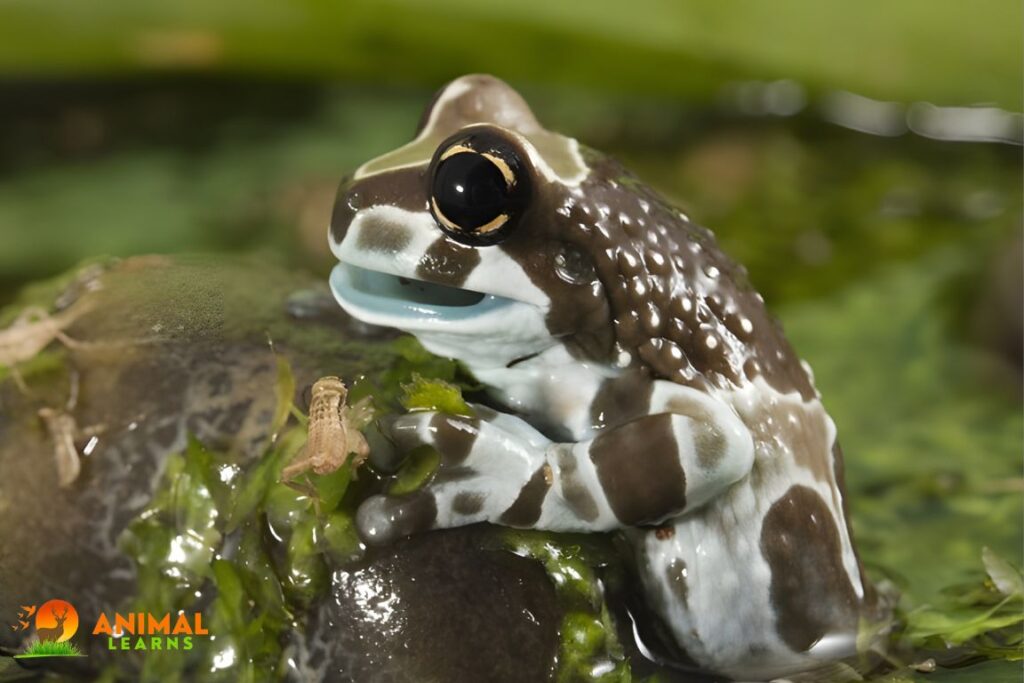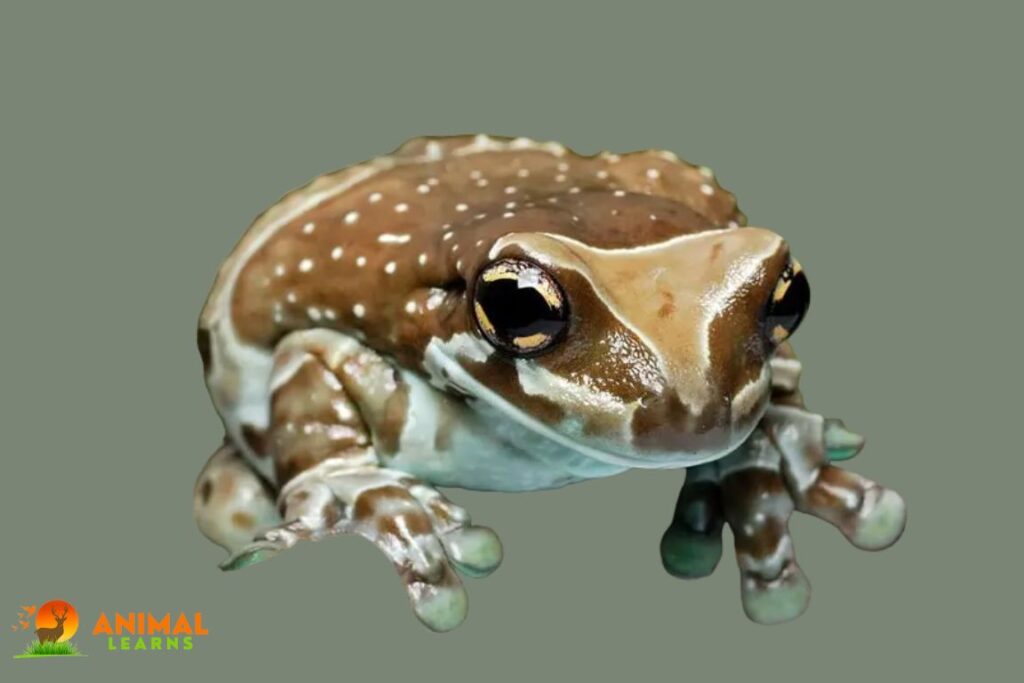Amazon Milk Frog Care Sheet – Animallearns

| Feature | Description |
| Scientific Name | Trachycephalus resinifictrix |
| Common Names | Amazon Milk Frog, Mission Golden-Eyed Tree Frog, Blue Milk Frog |
| Type of Animal | Amphibian |
| Diet | Insectivores (crickets, moths, grasshoppers) |
| Habitat | Rainforest canopy in South America |
| Size | Adults: 3-4 inches long |
| Lifespan | 10-15 years in captivity |
Ensuring optimal Amazon Milk Frog care involves creating a habitat with high humidity, providing a variety of live insects for a balanced diet, and maintaining a suitable temperature range.
Native to the Amazon Basin of South America, Amazon milk frogs (Trachycephalus resinifictrix) are tiny to medium-sized, nocturnal, arboreal amphibians. For a home, they like the canopy of a forest with access to tree holes that are full of water.
The soft, 2.5–4” long Amazon milk frogs have round, sticky toe pads, and rough skin. Usually, they have some spotting and a pattern of turquoise-gray and brown bands.
They are known as “gold mission frogs” because of their golden eyes and black mission cross through the pupil. At night, they make a loud call.
Because of their amazing tolerance, Amazon milk frogs are an excellent choice for beginning amphibians. They can survive for eight years or more if given proper care.
Milk Frog Size
Contents

Male milk frogs attain a maximum length of 2.5 inches as adults. The female may grow up to 4 inches and is bigger. These tree frogs have huge bodies, massive toe pads, large hands for climbing, and a rotund overall look.
Milk Frog Life Span
It is possible for milk frogs kept in captivity to live up to eight years. A long-living captive frog can be achieved by providing varied food and ideal environmental conditions, such as UVB illumination and the proper temperature.
Amazon Milk Frog Care
Milk Frog Caging
A bigger habitat of 24″L x 18″D x 24″H is large enough for a group of five adult milk frogs, whereas a normal 20-gallon aquarium is sufficient for one or two.
To facilitate easier monitoring, juveniles should be kept in smaller containers, such as 10-gallon aquariums. To provide enough ventilation, use a screen cover, such as the Zilla Fresh Air Screen Cover.
You may use a substrate made of wet paper towels or sphagnum moss, such as the Zilla Fir & Sphagnum Peat Moss Mix Reptile Bedding, however, other individuals would rather not use a substrate at all and only clean the enclosure’s bottom.
Because milk frogs are very arboreal and never, if ever, leave their tree home, they need additional habitat and resources for frogs. Provide elevated surfaces for perching, such as PVC pipe segments, bamboo poles, or cork bark.
Both real and artificial plants can be employed. If you are utilizing live plants, choose robust cultivars such as giant Neoregelia sp. bromeliads or Philodendron large-leafed species.
Large, wet tree holes are the breeding grounds and hangouts for milk frogs in the wild. A large water dish will work well for this in captivity. Use only tap water that has had chlorine or chloramines removed, and change the water every day.
Every few weeks, the enclosure as a whole has to be cleaned. When cleaning the cage, use hot water to assist in removing waste if needed, rather than soaps or detergents.
Milk Frog Temperature and Humidity
To ensure optimal Amazon Milk Frog care, it’s crucial to maintain a consistent temperature and humidity in their habitat. During the day, let one section of the cage go as high as 80–85°F, while the other, colder sections should only get as high as 70–75°F. The temperature can drop below 65°F at night.
If necessary, heating can be accomplished using incandescent light bulbs, such as the Exo Terra Night Heat Bulb Reptile Lamp. Make sure you take a temperature reading using a precise thermometer, like the Zoo Med ReptiTemp Digital Infrared Thermometer.
50–100% humidity is a good range. Using a reptile mister, spritz the cage once a day to create brief increases in humidity. For misting, you can use reverse osmosis (RO) water or dechlorinated tap water.
Milk Frog Lighting
It is a good idea to use suitable amphibian light fixtures to offer UVB illumination for milk frogs kept in captivity. Make sure to place a UVB bulb, such as Zoo Med’s Reptisun UVB Compact Fluorescent Bulb, over a screen portion of the cover when using a strength of 2.0 or 5.0.
The bulb has to be changed once a year. To make the enclosure appear more natural, you may use another fluorescent light in addition to a UVB lamp. This second light should have a color temperature of between 5000 and 6500K.
Amazon Milk Frog Diet & Water

Give a range of live invertebrates to milk frogs. The diet can consist mostly of crickets, with occasional additions of other items including earthworms, cockroaches, and house flies.
Young frogs can also be fed flightless fruit flies. Feed young frogs daily and adults just once a week or so, providing three to ten food items per frog at a time.
To assist in avoiding nutritional issues, it’s critical to take a high-quality vitamin and mineral supplement. Choose a supplement that has vitamin D3 and A but no phosphorus.
For developing juveniles, cover food with this supplement at every feeding; for adults, do the same every other feeding.
To keep the vivarium hydrated, sprinkle it with water each morning. An additional freshwater source might be a water bowl.
Cleaning

Keeping Amazon Milk Clean Because they are large frogs, frogs may create a lot of mess. Every day, water bowls should be washed clean using hot water.
At least once a week, switch out the substrate and use a 5% bleach solution to clean the enclosure and accessories. Paper towels should be cleaned daily if they are used as a substrate.
Milk Frog Handling
Handle milk frogs only when required, such as when taking them out to clean their cage or assess their health. The skin of milk frogs, like that of other amphibians, is porous and sensitive to the natural oils and salts present in human skin. When handling milk frogs, you can use disposable gloves devoid of powder.
Milk Frog Behavior

Being nocturnal creatures, milk frogs usually slumber throughout the day. In captivity, they frequently spend the night hidden within hollow cork bark tubes or other constructions of a similar nature.
The greatest time to view them is at night when they become active. A mist of water in the terrarium or feedings during the day can cause many milk frogs to wake up as well.
Provide a comfortable home with a consistent temperature range as part of your Amazon Milk Frog care regimen to ensure that these unusual amphibians may live long and prosper.
FAQs
What temperature should I maintain for my Amazon Milk Frog?
Keep their habitat between 75-82°F for optimal well-being.
How often should I feed my Amazon Milk Frog?
Feed them 2-3 times a week with a diet of insects like crickets and flies.
How do you take care of Amazon milk frogs?
Maintain a warm habitat, feed them insects 2-3 times a week, and provide a humid environment.
Do Amazon milk frogs like water?
Yes, they enjoy water, and a shallow, clean water bowl in their enclosure is beneficial.
Are Amazon milk frogs good for beginners?
Yes, they are suitable for beginners due to their hardiness and adaptability to captive environments.












